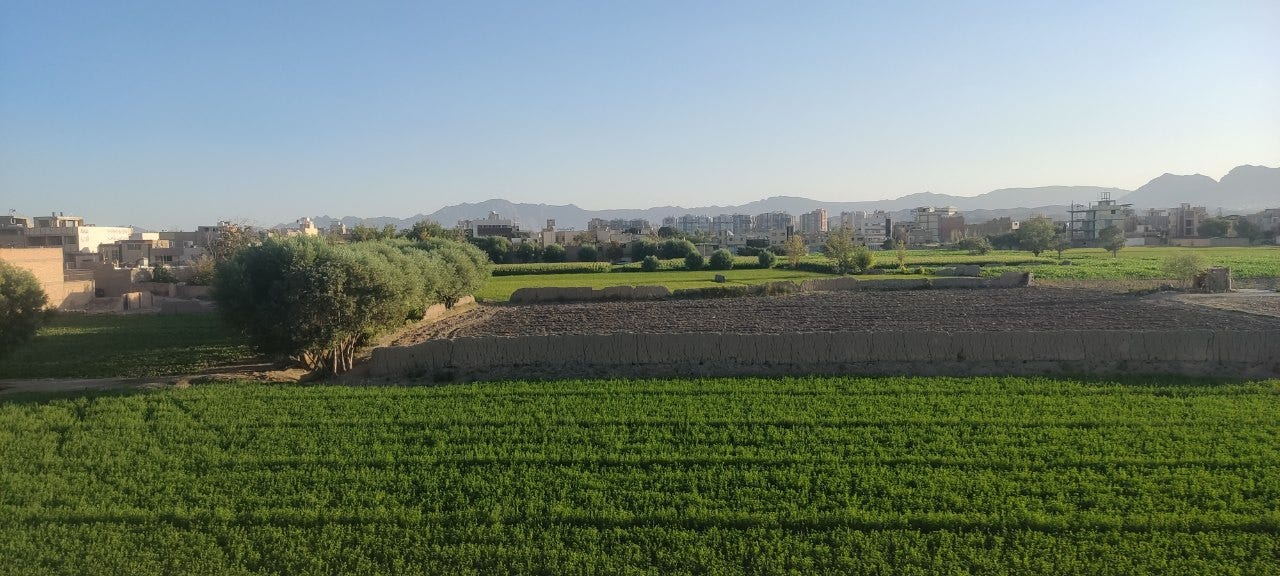You Can’t Pump Forever
From Wells to Warnings: The Cost of Over-pumping in Central Iran and the Central Valley
The hum of a camouflaged, illegal water pump echoed through a dusty, sunburned neighborhood on the fringes of Isfahan, in the parched heart of Iran.
Isfahan, for the record, is one of those cities that’s literally sinking—crumbling under the weight of decades of unregulated groundwater addiction.
The air was blistering, as always. And there, defying both common sense and climate data, a stubborn patch of rice paddies shimmered in the middle of urban sprawl—like a tropical hallucination sewn into the corpse of a collapsing landscape.
Back in the day, when the Zayandeh Rud River still had the nerve to flow, narrow irrigation channels called madi quietly nourished gardens and farmlands. But now that the river spends most of the year as a dry scar on the map, it’s the guttural growl of thirsty diesel pumps that has replaced the whisper of flowing water.
Saman—known to his friends (with varying degrees of irony) as Sam—was a geology teacher with sharp eyes, sharper words, and the patience of someone who teaches science in a collapsing ecosystem. He stood at the edge of the field, arms crossed, tone locked and loaded.
“Jamal,” he called out, “are you seriously growing rice inside city limits? Using groundwater? That well should’ve been sealed when disco was still a thing. The ground is literally collapsing beneath us, and you’re out here acting like it’s 1973. Ever heard of subsidence? Groundwater over-extraction? No?”
Jamal, shovel in hand, didn’t flinch. He smiled, the kind of smile you only see on a man casually irrigating the apocalypse.
“Oh, come on. You act like it’s just us. Just Isfahan. Just Iran. You think we invented land subsidence? Ever heard of California’s Central Valley? Same disaster, different time zone. And don’t tell me they’ve cleaned up their act. Those corporate farms drain aquifers like it’s an Olympic sport — and spoiler alert: they’re undefeated.”
Jamal’s son, Mehdi— your typical Wi-Fi-enabled, satellite-map-obsessed teenager — suddenly popped up from nowhere and jumped into the conversation:
“He’s right. I read it online — somewhere legit, like NASA. Parts of the southern Central Valley — Corcoran, Tulare — are sinking up to a foot(and even more) a year. A foot! And that’s with satellites watching from space like babysitters with PhDs. You really think the U.S. government’s gonna take on Mega Almond Inc.? Yeah, sure. And maybe cows will start importing alfalfa and corn from Mars while they’re at it.”

Sam adjusted his glasses with the exhausted elegance of a man who’s explained gravity to flat-earthers one too many times.
“Yes, but here’s the difference. They have a law. In 2014, California passed SGMA—the Sustainable Groundwater Management Act. Every groundwater basin has to reach sustainability by 2040. Farmers are required to track how much they pump. Groundwater agencies must submit real plans. And when it rains—which is rare, but still—they’re supposed to recharge aquifers instead of letting the water run off to oblivion. It’s not perfect, but at least it pretends to be a system.”
Jamal gave a dry, familiar smirk—the kind that usually shows up right before something collapses.
“Oh, we had a law too. Beat ’em to it, actually. Back in 2006, the Ministry of Energy rolled out the ‘Groundwater Rehabilitation and Balancing Plan.’ Said all the right things: reduce pumping in overdrawn plains, stabilize water tables, involve stakeholders, fix the cropping patterns…”
Sam raised an eyebrow. He already knew where this was going.
“So what happened?”
Mehdi jumped in again. “The usual. They printed reports. Held flashy conferences. Waved banners about ‘crisis management.’ Meanwhile, the illegal wells kept running, the rice kept growing, and the regulators? Turns out a lot of them owned rice fields too. Shocking, I know.”
Sam sighed and wiped the dust from his face, like he was trying to erase the whole scene.
“That’s the warning, Jamal. A law is just ink on paper unless someone actually believes in it. In Iran, we’re almost out of time. In California’s Central Valley, maybe—maybe—there’s still a window. But the land? It doesn’t care about legislation. And when the ground keeps sinking, it loses the ability to store water. You can’t bank what the earth can’t hold. You can’t un-sink a basin. And what you and your buddies are doing is writing a check that future generations will have to cash—with no water left in the vault.”
Sam’s voice dropped—flat and dry, like the cracked earth beneath their feet:
“Truth is, once the ground starts sinking, no lawsuit, no slogan, and no subsidy is going to lift it back up.”







Thank you Nikan jan...👌